Pataca
|
|
The Pataca is the monetary unit of Macau (currency code MOP). Monetary policy is managed by the Monetary Authority of Macau. The abbreviation MOP$ is commonly used. 1 Pataca is divided into 100 "Avo". The name "pataca" was derived from the then popular silver coin in Asia, the Mexican eight Reales, known in Portuguese as the Pataca Mexicana. The Pataca was also used in Portuguese Timor, now East Timor, until 1957, when it was replaced by the Escudo.
1pataca.jpg
| Contents |
The History of Pataca Issues
The bank notes and coins are in the following denominations:
- Bank notes: 10, 20, 50, 100, 500 and 1000 Patacas
- Coins: 1, 2, 5 and 10 Patacas; 10, 20 and 50 avos
At the time of the first issuance, the only denominations were 1 Pataca, 5 Patacas, 10 Patacas, 25 Patacas, 50 Patacas, and 100 Patacas, with the 20-Cent coin from Canton Province. Later, Macau began issuing 5 Avos, 10 Avos, and 50 Avos in February 1920. Not until 1942 did Macau issue smaller denominations like 1 Avo, 5 Avos, and 20 Avos. The new note comes with underprint in yellow, a traditional Chinese dragon on the obverse, a view of Macau city on the reverse, and a Chinese junk watermark. The date printed was August 8, 1988. Because 8 in Chinese (Ba) is similar to "getting rich" (Fa), this unique date which occurs only once per century gives the note a special meaning. Another feature is the replacement of the Portuguese Coat of Arms with Banco Nacional Ultramarino's logo, symbolizing the fact that Macau is part of the People's Republic of China.
The Pataca has been the legal tender in Macau for nearly a century. The Banco Nacional Ultramarino (BNU) has been the banknote-issuing authority since 1905. The pataca banknotes have been circulated in Macau since January 27, 1906. The Pataca coins were first issued in 1952. However, owing to the small market demand in Macau, the second issue was postponed until 1967. The coins were bronze 5 and 10 avos, cupro-nickel 50 avos and silver 1 and 5 patacas.
In 1980, the Macau Government transferred the exclusive right to issue patacas to the Instituto Emissor de Macau (IEM). The BNU became the IEM's agent bank and continued to issue banknotes. On agreement with the BNU on October 16, 1995, the Bank of China (Macau Branch) became the second note-issuing bank. The authority to issue patacas was transferred to the Portuguese-administered Government with the establishment of the Monetary Authority of Macau (AMCM). After December 20, 1999. The Government of Macau Special Administrative Region vested the AMCM with the authority to issue patacas.
 Missing image
Missing imageMcau005b.jpg
1 Pataca
On the obverse of this coin are two Chinese characters writting in Li Shu [a scribe style] meaning 5 cents in the centre, above and below two rosettes within a linear circle. The words REPUBLICA PORTUGUESA appear in the upper outer circle, and 5 AVOS in the lower outer circle. On the reverse of this coin, the armorial bearing of Macau is in the centre, and above is the name MACAU. Below is the yeardate 1952, and on the right and left are two Chinese characters (meaning "Macau") and there are two small stars above and below.
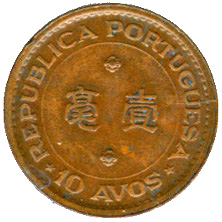 Missing image
Missing imageMacau10b.jpg
1 Pataca
The inscriptions borne on both sides of this coin are the same as on the 5-Avo coin, except the denomination is 10 Avos in Portuguese and 10 cents in Chinese. This coin, like other earlier Macau coins was minted by Casa da Moeda of Lisbon.
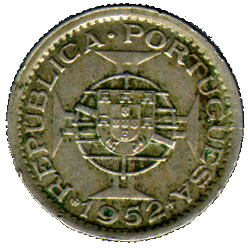

This coin was made with copper-nickel, though it looks like silver. On the obverse side of this coin is Portugal's coat of arms overlaying a cross, the words REPUBLICA PORTUGUESA above and 1952 below the cross. On the reverse of this coin are the armorial bearings of Macau in the centre, the name MACAU above, "50 AVOS" below, and to the right and left, four Chinese characters meaning "Macau" and "50 cents") with two small stars above and below.
Macau1a.jpg
1 Pataca

The obverse and reverse of a 1 Pataca coin issued in 1952. This coin was made with copper-nickel, though it looks like silver. On the obverse side of this coin is Portugal's coat of arms overlaying a cross, the words REPUBLICA PORTUGUESA above and 1952 below the cross. On the reverse of this coin are the armorial bearings of Macau in the centre, the name MACAU above, "50 AVOS" below, and to the right and left, four Chinese characters meaning "Macau" and "50 cents") with two small stars above and below.
Mcau715a.jpg
1 Pataca
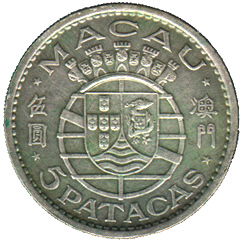
This is another 5-Pataca coin issued in 1971. The mintage of this coin is small too.
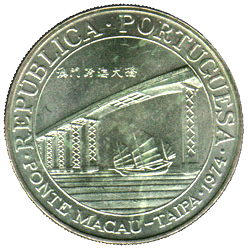
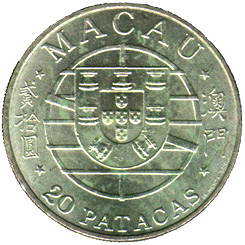
This silver 20 pataca coin was struck by the Macau government to commemorate the opening of the Macau-Taipa Bridge in 1974. This is the only 20-pataca silver coin issued for general circulation. On the obverse of this coin is a scene showing the Macau-Taipa Bridge, and a Chinese junk is just passing under the bridge in the centre circle. In the upper outer circle are the words "REPUBLICA PORTUGUESA", and in lower outer circle "PONTE MACAU-TAIPA 1974". The inscriptions on the reverse of this coin are the same as on the 50-Avo coin, except that the denomination is 20 Patacas in Portuguese and 20 dollars in Chinese.
Rareness of particular Pataca coins
The coinage of Macau started late in 1952. The first issued mintage was probably too large for the small market demand of Macau. The second issue was postponed until 1967. Macau's coinage consisted of bronze 5 and 10 avos, cupro-nickel 50 avos and silver 1 and 5 patacas.
According the information from the Portuguese Government of Macau and the Banco Nacional Ultramarino (BNU), the Portuguese Government of Macau issued 1 Pataca coins in 1976. From this, it is known that Macau 1976 1-Pataca coins are rare.
Exchange rate indicators
The following figures are included as a guide to the movements of the Pataca against Sterling and the US Dollar:
| Date | Feb ’03 | May ’03 | Aug ’03 | Nov ’03 |
| £1.00= | 12.79 | 13.15 | 13.24 | 13.94 |
| $1.00= | 8.03 | 8.03 | 8.30 | 8.25 |
Other currency used in Macau
The Pataca is circulated in Macau, but Hong Kong dollars (HK$) are also accepted. The Pataca, with a mere 29.9% share of Macau's money supply at the end of 1998, could conveniently be replaced by the Hong Kong dollar, which accounted for 52.8%. The exchange rate is loosely pegged and is approximately MOP$103=HK$100 as of February 2004, although the variation is up to 10%. For United States dollars, to which the Hong Kong dollar is in turn pegged, the exchange rate is around 8 Patacas to 1 US dollar.
Now in Macau
Nowadays, the most significant financial authority in Macau is the Monetary Authority of Macau. It allows Macau citizens to buy foreign currencies with the Macau Pataca directly in banks or money exchange centres. As there are currently no restrictions on the import or export of either local or foreign currency into or from Macau, visitors can change their currency in hotels, banks and authorized exchange dealers located all around the city. There are also 24-hour exchange counters at Macau International Airport (Taipa Island) and at the Lisboa Hotel (Macau Peninsula) for customers if they want to change their currency into Patacas outside working hours.
External links
- Main Currencies List worldwide (in Chinese) (http://www.cp-edu.com/TW/CIKU/free_html/fl_sjzyhbjb.asp)
- Summary of the Pataca (http://www.amcm.gov.mo/history/pataca_info.htm)
